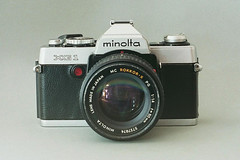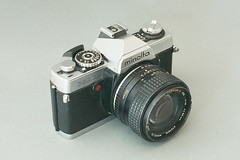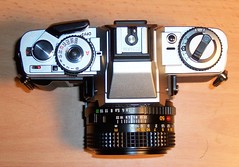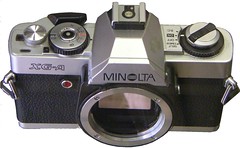Difference between revisions of "Minolta XG series"
Rebollo fr (talk | contribs) (plainlinks, picture at the top and minor markup) |
(Just a start. (There's a lot more to be done.)) |
||
| Line 2: | Line 2: | ||
[http://www.flickr.com/photos/50678983@N00/199807809/in/pool-camerapedia/ http://farm1.static.flickr.com/28/199807809_2c622ba2a1_m_d.jpg] | [http://www.flickr.com/photos/50678983@N00/199807809/in/pool-camerapedia/ http://farm1.static.flickr.com/28/199807809_2c622ba2a1_m_d.jpg] | ||
</div> | </div> | ||
| − | The '''[[Minolta]] XG''' cameras | + | The '''[[Minolta]] XG''' cameras are 35mm SLRs of the Minolta SR system, sold from 1977 to 1984. |
== General description == | == General description == | ||
| − | The Minolta XG series was launched together with the | + | The Minolta XG series was launched together with the much more sophisticated [[Minolta XD series]] in 1977 as a budget line of small, lightweight and easy-to-use electronic SLR with an automatic exposure mode. As a first in the line-up of Minolta SLRs, these cameras were inoperable without a battery. They still used the outdated CdS metering system and had a competitive cloth shutter. In the aperture priority automatic mode, the electronically governed shutter provided stepless speeds from 1s to 1/1000s. The big news was the so-called "Touch Switch": After powering the camera up via the main switch, it was in stand-by mode. By just slightly touching the release button, the photographer activated the electronics and the LEDs lit up for about 15 seconds. All XG bodies featured an ±2 EV exposure compensation. The XG series had a dedicated motor drive, the '''Winder G''' and the flagship of the series, the [[Minolta XG series#Minolta XG-M & X-70|XG-M]], could even be mounted on the 3.5-fps '''Motor Drive 1'''. Also a data back, the '''Data Back G''' was available. This series can be seen as the ancestor of the most successful of all manual Minolta SLRs, the famous [[Minolta X-700]]. |
== Minolta XG-E, XG 7 & XG 2 == | == Minolta XG-E, XG 7 & XG 2 == | ||
| Line 11: | Line 11: | ||
=== Body and features === | === Body and features === | ||
| − | The XG-E | + | The XG-E is considerably smaller and lighter than the recent cameras like the [[Minolta XE|XE]] or [[Minolta SR-T 101|SR-T]] series. It has a center-weighted metering system with two CdS cells and a matte-fresnel-field focusing screen with a horizontal split-image spot surrounded by a microprism field. The viewfinder shows the automatic shutter times from 1s to 1/1000s via LEDs. Unfortunately in manual mode the LED does not show the metered shutter time. In automatic mode the camera blocks the shutter if the triangular overexposure LEDs (at the top end of the LED sacle) indicate a shutter time shorter than 1/1000s. The shutter dial shows the manual times from 1s to 1/1000s, B and A for aperture priority and it allows the ASA setting. In order to override the automatic chosen speed, the dial can be turned so that "A" faces a number between -2 and +2 in full stops. The back with a memory holder and a DIN/ASA conversion scale is interchangeable with the later available '''Data Back G'''. The bottom of the camerea has coupling for the '''Winder G''', introduced with the camera. The main power switch has a self timer setting, which delays the shutter actuation for approximately 10 seconds. A red light on the front flashes until the shutter fires. The same light is used for the B.C. (battery check) setting of the main switch. The flash shoe is the same as with the XD series and has a second small contact. This contact synchronizes the camera with a dedicated Minolta X-Flash like the '''Auto Electroflash 200X'''. In A mode with powered-up flash in the shoe, the camera automatically sets the shutter time to 1/60s and the blinking LED serves as a flash ready signal. Besides the X-contact in the flash shoe, it has a flash terminal at the lens bayonet. Next to it is a socket for an electronic cable release like '''Remote Cord S''' or '''L''' or a mechanical cable release. The camera doesn't have a stop-down button. |
| − | === Aperture priority and | + | === Aperture priority and manual mode === |
| − | The [[Minolta]] XG-E | + | The [[Minolta]] XG-E is a dual-mode camera. It has an aperture-priority mode "A" which obviously is metered. Metering is done by depressing the shutter button halfway. The shutter speed then selected by the camera is shown in the viewfinder by a red LED. In the "A" mode you can "force" the camera to under- or overexpose your pictures by up to two stops. In situations requiring too fast a shutterspeed, faster than 1/1000s, the camera will not fire to prevent overexposure. This is indicated by a red triangle in the viewfinder. Stop down the lens until a shutter speed is shown and you're ready to shoot again. |
Curiously, the manual mode is non-metered. Reviews on the web suggest Minolta wanted to avoid confusion. | Curiously, the manual mode is non-metered. Reviews on the web suggest Minolta wanted to avoid confusion. | ||
Revision as of 16:18, 3 February 2007
The Minolta XG cameras are 35mm SLRs of the Minolta SR system, sold from 1977 to 1984.
Contents
General description
The Minolta XG series was launched together with the much more sophisticated Minolta XD series in 1977 as a budget line of small, lightweight and easy-to-use electronic SLR with an automatic exposure mode. As a first in the line-up of Minolta SLRs, these cameras were inoperable without a battery. They still used the outdated CdS metering system and had a competitive cloth shutter. In the aperture priority automatic mode, the electronically governed shutter provided stepless speeds from 1s to 1/1000s. The big news was the so-called "Touch Switch": After powering the camera up via the main switch, it was in stand-by mode. By just slightly touching the release button, the photographer activated the electronics and the LEDs lit up for about 15 seconds. All XG bodies featured an ±2 EV exposure compensation. The XG series had a dedicated motor drive, the Winder G and the flagship of the series, the XG-M, could even be mounted on the 3.5-fps Motor Drive 1. Also a data back, the Data Back G was available. This series can be seen as the ancestor of the most successful of all manual Minolta SLRs, the famous Minolta X-700.
Minolta XG-E, XG 7 & XG 2
The XG-E (XG 7 in USA and Canada, XG 2 in Europe and elsewhere) was the first model of this series to be introduced in 1977. All models were available in chrome and black finish.
Body and features
The XG-E is considerably smaller and lighter than the recent cameras like the XE or SR-T series. It has a center-weighted metering system with two CdS cells and a matte-fresnel-field focusing screen with a horizontal split-image spot surrounded by a microprism field. The viewfinder shows the automatic shutter times from 1s to 1/1000s via LEDs. Unfortunately in manual mode the LED does not show the metered shutter time. In automatic mode the camera blocks the shutter if the triangular overexposure LEDs (at the top end of the LED sacle) indicate a shutter time shorter than 1/1000s. The shutter dial shows the manual times from 1s to 1/1000s, B and A for aperture priority and it allows the ASA setting. In order to override the automatic chosen speed, the dial can be turned so that "A" faces a number between -2 and +2 in full stops. The back with a memory holder and a DIN/ASA conversion scale is interchangeable with the later available Data Back G. The bottom of the camerea has coupling for the Winder G, introduced with the camera. The main power switch has a self timer setting, which delays the shutter actuation for approximately 10 seconds. A red light on the front flashes until the shutter fires. The same light is used for the B.C. (battery check) setting of the main switch. The flash shoe is the same as with the XD series and has a second small contact. This contact synchronizes the camera with a dedicated Minolta X-Flash like the Auto Electroflash 200X. In A mode with powered-up flash in the shoe, the camera automatically sets the shutter time to 1/60s and the blinking LED serves as a flash ready signal. Besides the X-contact in the flash shoe, it has a flash terminal at the lens bayonet. Next to it is a socket for an electronic cable release like Remote Cord S or L or a mechanical cable release. The camera doesn't have a stop-down button.
Aperture priority and manual mode
The Minolta XG-E is a dual-mode camera. It has an aperture-priority mode "A" which obviously is metered. Metering is done by depressing the shutter button halfway. The shutter speed then selected by the camera is shown in the viewfinder by a red LED. In the "A" mode you can "force" the camera to under- or overexpose your pictures by up to two stops. In situations requiring too fast a shutterspeed, faster than 1/1000s, the camera will not fire to prevent overexposure. This is indicated by a red triangle in the viewfinder. Stop down the lens until a shutter speed is shown and you're ready to shoot again.
Curiously, the manual mode is non-metered. Reviews on the web suggest Minolta wanted to avoid confusion.
Pictures
- XG-E at Syoji Nishida's site
- XG 7 chrome at Syoji Nishida's site
- XG 7 black at Syoji Nishida's site
- XG 2 chrome at Syoji Nishida's site
Minolta XG 1
The XG 1 was the second to appear in the XG series in 1979. It was basicly a XG-E with a less informative finder display and a non-detachable back door. It was available in two versions in chrome finishing only and was an export model, which wasn't sold in Japan.
Body and features
Besides the fixed back door, the XG 1 had a simplified viewfinder read out: The range between 1/15s and 1/2s was now represented by one LED. Further it lacked the memo holder and had just a DIN/ASA conversion scale instead.
Versions
In early 1982 it got the new "rising sun" logo on the prism cover, and model designation now included a hyphen: The XG 1 became a XG-1. Later that year, the XG 1 was replaced by the XG-1(n) with a new body design, that included a plastic front grip like the XG-M. It was equiped with the 'Acute Matte' focusing screen and a red M lighting in the viewfinder when leaving the auto mode. Although in manual mode, the meter is not working. The XG-1(n) finally got the memo holder on the back door. Although the box, manual and other literature refered to this camera as XG-1(n), the camera itself was engraved with XG-1.
Pictures
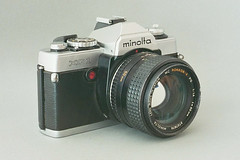 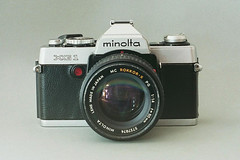 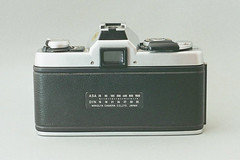
|
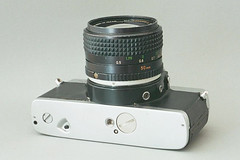 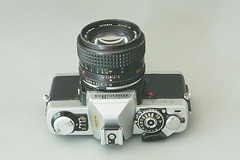
|
Minolta XG-SE
The XG-SE was a rebagded XG 1 in black finish and equipped with the new 'Acute Matte' focusing screen, hitting the shelves shortly after the XG 1. It is reported, that the "SE" stands for "Special Edition". Like the XG-1 it was an export model.
Pictures
Minolta XG-S & XG 9
In late 1979 Minolta revealed the XG-S. Outside Japan, this model was known as XG 9, and with its improvements, it addressed some weak points of the XG-E, which it replaced. Both bodies were available in chrome or black finish.
Body and features
The XG-S had all features, the XG-E had, but added or changed the following points:
- The viewfinder showed the set aperture at the bottom
- A stop down button was added
- The new and much brighter "Acute Matte" focusing screen preplaced the fresnel field screen
This was a big leap ahead and left only one major draw back of all XG models untouched: The non-working meter read out in manual mode.
Pictures
Minolta XG-M & X-70
The flagship of the XG series, the XG-M, was introduced in 1981. It was completely new designed and looked like a twin sister to the eight months later introduced Minolta X-700. It replaced the XG 9 in its markets. The XG-M was available in chrome only. The japanese version was labelled X-70 (chrome finish only), which emphasised its position as a little sibling of the Minolta X-700, and it was introduced in after the Minolta X-700.
Body and features
This model finally corrected the biggest downside of all earlier XG models: It had a meter read out in manual mode. Having all the features of the XG-S, this was now an adequate tool for photographing. The ASA setting and exposure adjustment moved to the rewind crank, the main switch under the shutter dial and the self timer got a dedicated switch close to the bayonet mount. The brand new Motor Drive 1 could be mounted, as well as the older Winder G and the Data Back G.
Pictures
Minolta X-7
In early 1980 Minolta released the X-7 for the domestic market. It was available in two versions.
Body and features
The X-7 can be seen as a simplified version of the XG-E. It lacked the manual shutter times and the DIN/ASA conversion scale on the film door. It featured a piezo beeper, which indicated shuter speed slower than 1/60s and went along with the flashing front LED in self timer mode. The top cover was slightly redesigned. The shutter dial showed only the Auto setting with a overriding scale from -2 to +2, B and X. This early model actually was available in chrome only, but a special edition in black (in very limited quantities) was released, too.
In 1981 the X-7 got a XG-M alike plastic front grip and the 'Acute Matte' focusing screen added. In 1982 the camera got the new 'rising sun' logo. These models were available in black only and have been exported to the world.
Versions
- First version in chrome finish
- A limited series of black finished first version bodies is known
- Second version in black finish with a plastic grip added on the right front side (XG-M style)
- Same as previous, but with new logo
Pictures
- X-7 chrome, first version at Syoji Nishida's site
- X-7 black, first version at Syoji Nishida's site
- X-7 black, second version at Syoji Nishida's site
Minolta XG-A
This camera was another version of the X-7 of the early chrome style, which had been redesigned with the new "rising sun" logo. It featured the shortened shutter time scale in the viewfinder of the XG 1, but was equipped with the 'Acute Matte' focusing screen. It lacked the piezo beeper of the X-7 and the PC sync terminal and the film door was not detachable. In contrast to the Japan only X-7, this model was an export model for the north american market. It was the last member of the XG family, beeing introduced in 1982, and available in chrome finish only.
Links
In English:
- Minolta XG series in the Rokkor Files
In German:
- Minolta XG 2 and repair notes for an XG 7 in Bodo Zurhausen's photo pages
In Japanese
